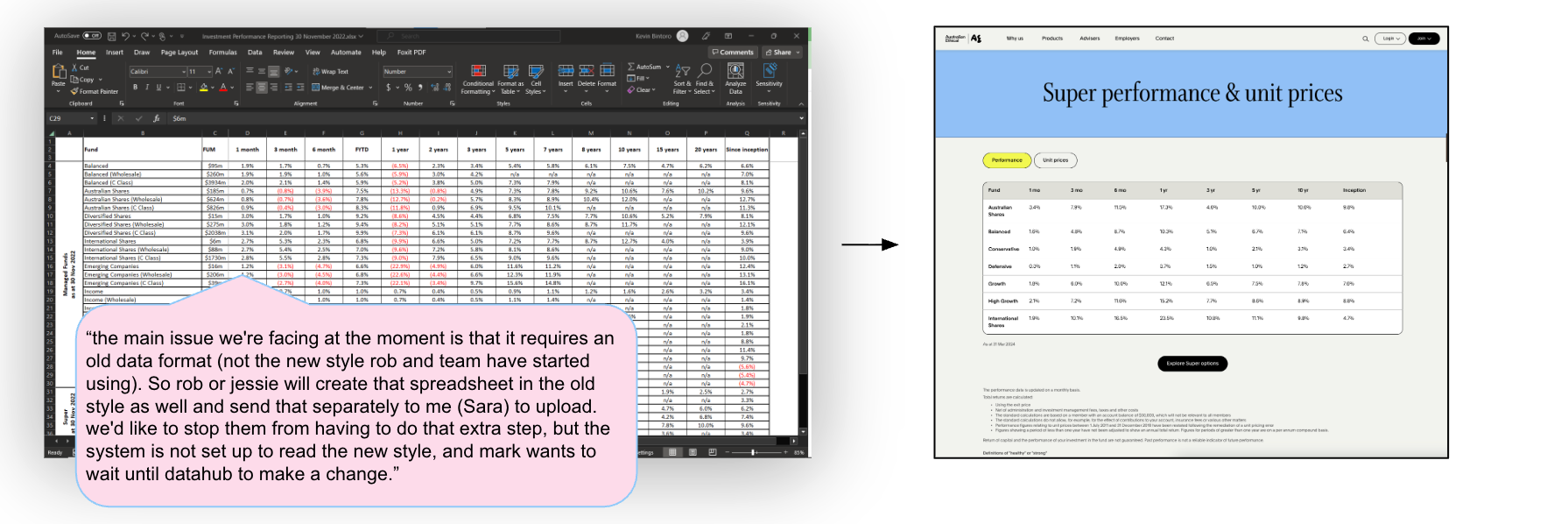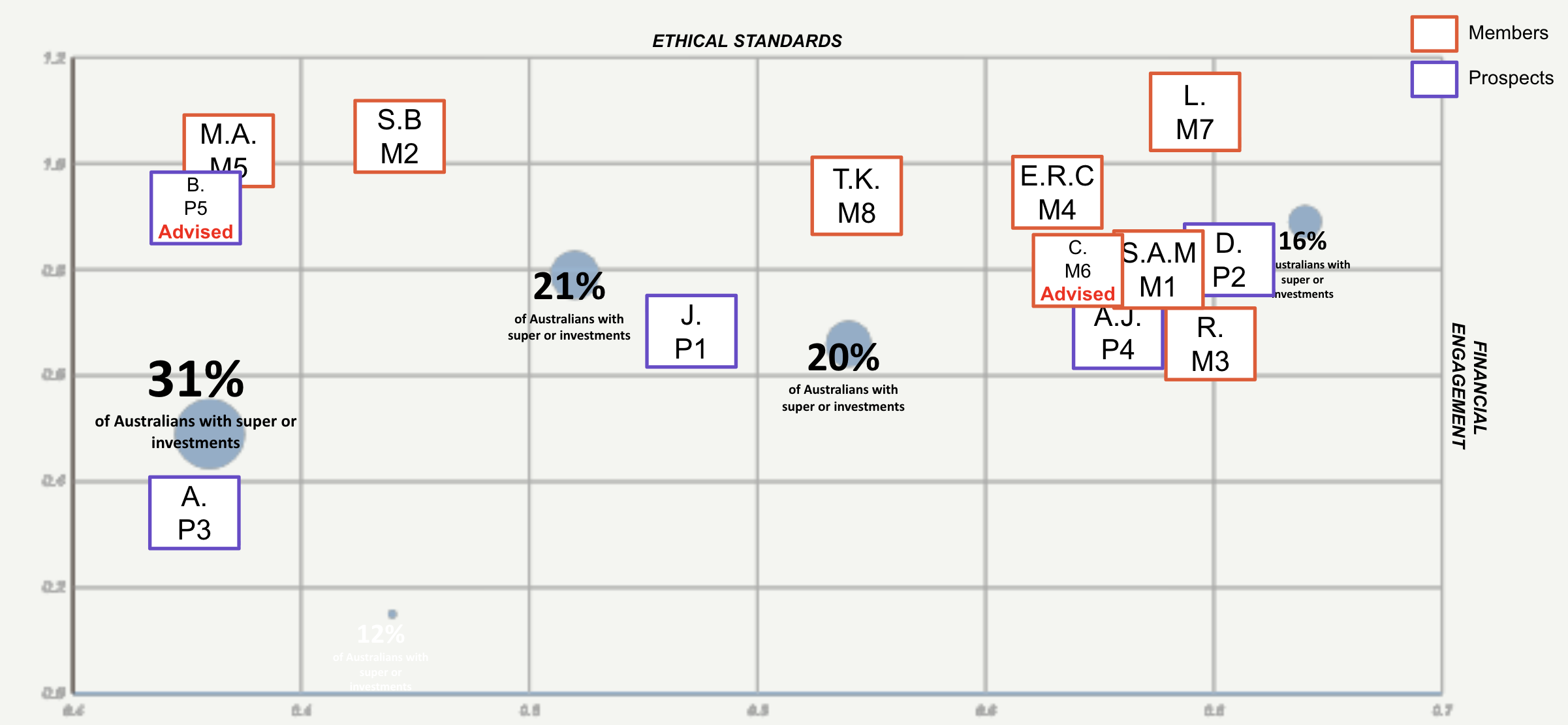27-point CSAT uplift and $240M in super transfers through a redesigned member acquisition experience.
Who are we?
Australian Ethical Investment is a purpose-driven superannuation and investment company, trusted by over 120,000 investors and managing more than $10 billion in assets with a strong ethical focus.
My experience
At Australian Ethical, I led a performance visualisation project that redefined how investment data was communicated. Over the course of nine months, I conducted user research, uncovered 10 key insights, and iteratively validated solutions. I collaborated cross-functionally to improve the public website and investor portal, enabling Product and CX teams to shift how AE communicates fund performance.
Case#1 - Superannuation Ethical performance strategy
Overview
Australian workers invest at least 10% of their lifetime income into superannuation. Australian Ethical needed to build trust in ethical investing and help customers feel confident about their retirement goals.
However, many investors chose Australian Ethical for its values, but values alone weren't enough to keep them. Without clear visibility into where their money was going and how those ethical investments were performing, investor confidence began to waver.
My Role
I collaborated closely with the Product Manager, Marketing, Engineering, and Compliance to:
Led discovery research
Analyse data to extract insight themes
Designs and User Testing
Align experiences across multi-channels touchpoints
UX Impact
Enabled Product and CX teams to shift how AE communicates fund performance
+27 Point uplift in CSAT
$240M Super transferred to AE
Helped shape roadmap priorities for both logged-in and public experiences
Problems
Challenges Faced by Australian Ethical Investments
#2
Risk of losing Trust:
Without clear visibility into where their money was going and how those ethical investments were performing, investor confidence began to waver.
#1
Customer Churn:
Many investors chose Australian Ethical for its values, but values alone weren't enough to keep them. Lack of performance visibility led to increasing churn rates.
#3
Demand for Transparency
A lack of accessible, easy-to-understand performance data led to a spike in support calls and CRM inquiries, highlighting both confusion and a growing risk of churn. 2-3% Contact centre surveys were concerned about the AE investment performance.
Design process
Phase 1 - Stakeholder Discovery
Understanding member needs and competitor landscape to redesign performance communication
Conducted 12 internal interviews across Investment, Fund Accounting, Design & Dev, Product, Customer Success, Content, and BA/PMO teams to understand existing constraints and opportunities.
Key Stakeholder Insights
#2
🎯 Benchmark Confusion
Members find competitor performance easy to grasp, but often overlook that results are after fees—this detail needs clearer emphasis.
#1
📈 Long-term Performance Gap
AE has achieved consistent growth long-term, but the website lacks visualization to show performance in an easy-to-understand manner.
#3
💻 Technical Constraint Discovery
The CMS struggles to manage large data volumes efficiently, with most workflows still handled manually by three separate teams.
Design process
Phase 2 - User Research
Most members fit the Ethical Advocate profile, though participants ranged from Balanced to Traditional. Two were advised members.
Conducted mixed-method research, including usability testing on both competitor and current website, across two segments—current customers and prospects—to understand expectations, needs, and behaviours when exploring super fund performance.
Users problems
#2
Will I have enough to retire?
With an average balance of $63K, many questioned whether their investments would generate enough returns to support a comfortable retirement.
#1
Is this really ethical?
Investors wanted to trust that every company in their portfolio met high ethical standards—but without transparency, they were left guessing.
#3
Why is it so hard to find answers?
Some users felt the lack of clear, accessible information was intentional, like Australian Ethical was hiding something, which eroded trust even further.
The goal is to uncover how investors interpret performance and use that understanding to guide their investment decisions.
The goal was to understand how investors interpret performance and what drives their decisions. By uncovering their mental models, we aimed to build trust and clarity around AE’s ethical investment performance—turning transparency into a driver of customer satisfaction and long-term retention.
Discovery Phase
Who are we solving for?
#1 Persona outline
Paul - Prospect customer
Interviewed +5 Prospects
Considering switching to a new fund, with ethical investing as a top priority
User goals:
Wants a balanced return, competitive performance and fair fees, especially for retirement
Needs to compare returns easily with other funds to make informed decisions
Has limited time and doesn’t want to deal with complicated financial terms or deep research
Believes that where he invests matters—he wants his money to reflect his values and contribute to a better world
Feels discouraged when information is hard to find, making him question the trustworthiness of the provider
#2 Persona outline
Elena - Existing customer
Interviewed +8 Existing member
Who raised some complains about performance of investments in AE
User goals:
Wants a balanced return, competitive performance and fair fees, especially for retirement
Needs to compare returns easily with other funds to make informed decisions
Has limited time and doesn’t want to deal with complicated financial terms or deep research
Believes that where he invests matters—he wants his money to reflect his values and contribute to a better world
Feels discouraged when information is hard to find, making him question the trustworthiness of the provider
Finding tour operators’ key pain to make the upgrade a no-brainer
To better understand operator workflows during peak seasons, I reviewed over 100 pieces of customer feedback. While only one directly requested the ability to set specific promo code dates, this surfaced a broader usability gap.
Analysis
Maze analysis
Customers Interviews
In follow-up interviews with five operators, a recurring issue became clear:
Many were manually recreating promo codes each week just to exclude weekends.
This reinforced the need for a more flexible, day-specific promo code management system.
What do our other booking software do better?
Few competitor platforms offer advanced scheduling features for promo codes.
#1
Flexibility in Day-Specific Customisation: While most operators typically apply discounts to weekdays or weekends, this flexibility also supports more nuanced use cases, such as targeting long weekends, public holidays, or off-peak days. Offering this functionality helps operators run more strategic, time-sensitive promotions that better align with booking behaviour.
What do our customers want to share with us?
I interviewed five tour operators to better understand how they currently use promo codes and where the system falls short. Insights were documented in Confluence for cross-functional alignment. Key themes emerged:
#1
Repetition: Operators were creating a new promo code each week just to exclude weekends, leading to unnecessary effort and system clutter.
#2
Control: Users lacked flexibility to define which days promo codes should be active, limiting their ability to run time-sensitive or targeted promotions.
#3
Efficiency: Managing availability manually each week introduced friction and made it difficult to scale promotional efforts during busy seasons.
Delivery Phase
Design and Development
Based on our research, we developed the following strategy for this project. A full rewrite was off the table, so we utilised existing UI to preserve consistency and speed up delivery.
Introduced the ability to assign promo code availability by day of the week, giving operators greater control and reducing manual setup efforts.
Success Criteria: Increase overall promo code usage through improved flexibility.
Restricted this feature to customers on the new pricing model to drive adoption and reinforce the value of transitioning.
Success Criteria: Boost plan migration and Gross Booking Value (GBV).
Rolled out the enhancement first to all users on the new pricing model, followed by a small group of legacy customers to gather feedback and test interest in switching.
Success Criteria: Validate user satisfaction and conversion potential before full release.
Validation Phase
From the prototype to the finished product
We followed a structured validation process to ensure usability and product-market fit:
Designed a high-fidelity prototype and launched an unmoderated usability test using Maze, with a Pendo survey deployed over the weekend to capture real-time feedback.
Engaged over 100 participants, collecting both qualitative input and behavioural data.
Received strong user responses and identified key usability improvements, which were documented for cross-functional visibility.
Collaborated closely with developers to refine the design, implement changes, and ensure seamless integration.
Established post-launch tracking to monitor adoption, usage patterns, and long-term performance.
Rollout Phase
Business Outcome
Just 8 weeks after launch, the new promo code experience earned strong praise from Rezdy and operators alike, highlighting smoother usability and greater efficiency.
#1
204 promo codes were created
#2
863 redemptions were recorded
#3
Generated approximately $229,000 USD in revenue
“It is easy to set up promo codes now!”
Rollout Phase
Business impact
#1
Feature Engagement: Promo code usage increased significantly in a short timeframe, indicating improved usability and relevance.
#2
Plan Adoption: 76% of eligible users transitioned to the new pricing model shortly after launch.
#3
Revenue Growth: The introduction of percentage-based transaction fees under the new plans contributed directly to increased revenue..
Learnings
When both the risk and effort of an initiative are low, move fast. Small wins can unlock big value.
Design doesn’t always have to start in Figma. Don’t hesitate to use creative tools like Inspect or browser-based experiments to explore and validate ideas quickly.
What THEY Say about me
“Joyce was the product designer on my team and brought clarity and user focus to our work every day. Joyce was tasked with adding complex features to help tour operators increase their bookings, which she was able to guide our team to execute and measure the success of. She was extremely collaborative with us engineers and even invited us to attend customer calls and grow our user empathy.”
THANKS FOR CHECKING IT OUT
Welcome to see my previous works UI Design projects







